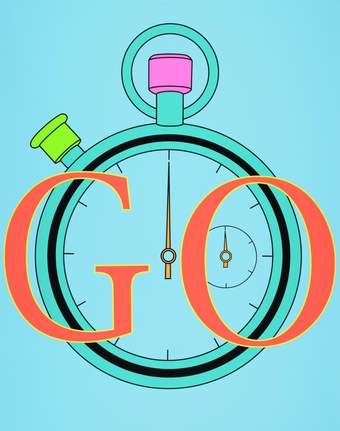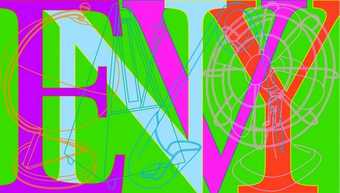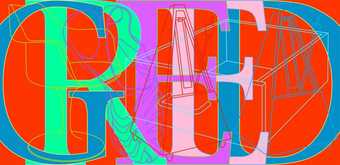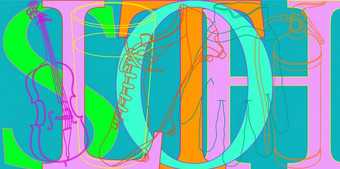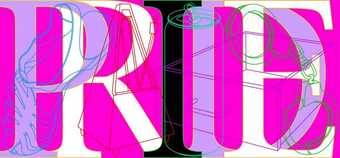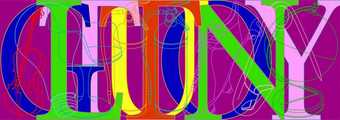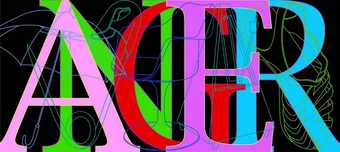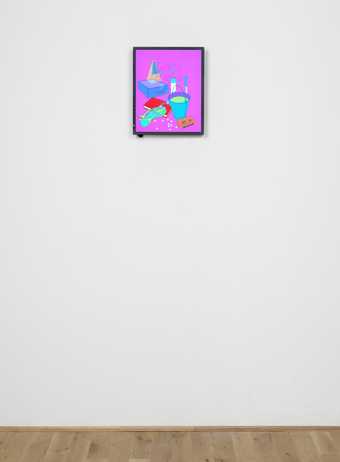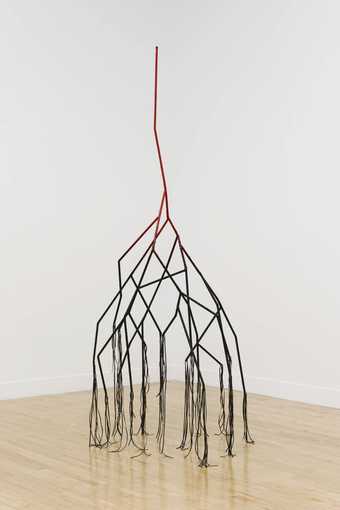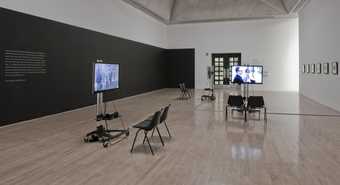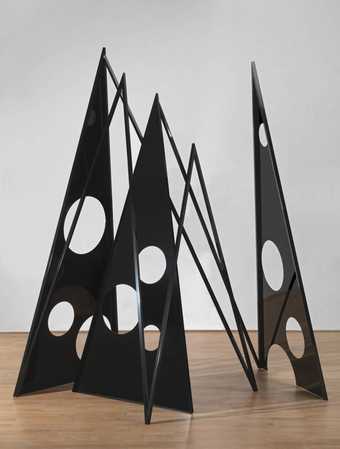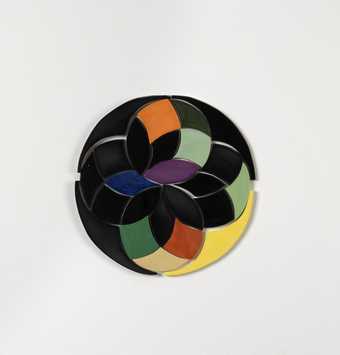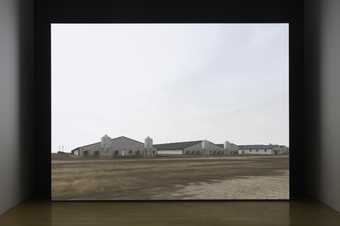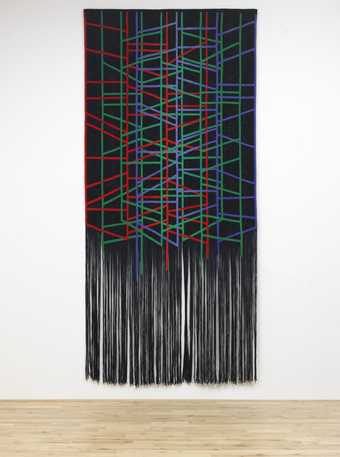
In Tate Britain
- Artist
- Yuri Pattison born 1986
- Medium
- Software, generative and networked, web, colour, environmental sensor, monitor, steel shelving, atomic clock, 2 padlocks, steel ruler and other materials
- Dimensions
- Object: 2000 × 2000 × 430 mm
- Collection
- Tate
- Acquisition
- Purchased with funds provided by Shane Akeroyd 2021
- Reference
- T15694
Summary
sun[set] provisioning 2019 is a free-standing sculptural work, measuring two metres wide by two metres high and just under half a metre in depth. It is a reiteration of the digital renderings of atmospheric conditions familiar from video game designs. In the work, a solar disk hovers at the horizon’s edge, dispersing illumination across a foreground of clouds and sky. As documented in exact detail in Pattison’s medium line, the sculpture consists of the following components: openGL software, modified Dell PowerEdge R620, NVIDIA GTX 1650 GPU, uRad A3 atmospheric monitor, HD monitor, Dexion slotted angle, cables, cutaway padlock, rubidium atomic clock, combination padlock and a steel ruler.
sun[set] provisioning is a product of Pattison’s interrogative, polemical and post-technological research practice. But, unlike some of the artist’s earlier works, it takes these ideas to their extreme logical conclusion. This is most apparent in the way that it collects digital information, tracking pollution levels in the air, and then translates this information visually as a constantly morphing, sublime, virtual reality ocean sunset that is then broadcast to a screen in the style of a public information board mounted on a metal desk-type framework. This metal framework is constructed from the classically industrial material Dexion. A lightweight, easily transported construction material that was developed in the middle of the twentieth-century in Britain, as well as being widely used for modular shelving systems, Dexion became a protagonist in narratives of British soft power deployment during its early years, particularly as a means of facilitating disaster relief programmes.
The endlessly morphing sunset/sunrise/moonrise in the work alludes to the phenomenon of spectacular sunsets that occur only because of high amounts of pollution in the atmosphere. Pattison mimics these (un)natural sunsets by measuring the levels of local pollution and, as the level increases, the more spectacular and colourful the rendering is. The monitoring system employed is known as a uRadMonitor – developed by Radu Motisan (a Romanian of the post-Chernobyl generation) to collect information from its immediate environmental surroundings and conditions, specifically: carbon dioxide, pollution particle matter (PM1/PM2.5/PM10), ozone, formaldehyde, temperature and humidity.
Pattison’s engagement with this small yet important piece of technology lies at the heart of this work. The device was developed to provide an accessible means of monitoring atmospheric conditions, independent of local government agencies. Oil spills, ongoing toxic waste disposal and emissions manipulation scandals have become common over past decades, despite supposed advances in safety technology. The values behind the creation of the uRadMonitor – openness, accessibility and scepticism in the face of official information channels – have come to take on even greater significance in a contemporary moment that has seen institutional climate change denial, corporate disinformation and the hyper-individualised discourse of environmental activism.
The data, collected in real time from the monitor connected to sun[set] provisioning, is interpreted and translated by the server and fed to the screen as ‘values’ which are rendered into virtual footage, resulting as the fabricated ocean sunsets. Every person’s actions may affect the totality of the globe, but no one individual can solve the crisis alone. sun[set] provisioning continually responds to the atmospheric conditions for the duration of its display, recapitulating the complex relationship between observed, experienced phenomena and the mediated representation of that same information. The work exemplifies Pattison’s wider exploration of the pervasive nature of new technologies, which increasingly influence how and where we live and work. He questions the impact of transparency and how the blurring of lines between leisure, work and domestic space shapes an increasingly abstracted sense of time, focusing particularly on the documentation and explanation of changes in our climate and environment; pervasive corporate and governmental power in relation to the control of the flow of information; and the democratisation of technology and transparency of technology companies.
Further reading
Rebecca O’Dwyer, ‘Yuri Pattison: sunset provision’, exhibition text, mother’s annual 2016, Mother’s Tankstation gallery, Dublin and London 2016, http://www.motherstankstation.com/wp-content/uploads/2017/02/mothers-annual-2016_Yuri-Pattison_sunset-provision_Copyright-all-rights-reserved.pdf, accessed 25 March 2020.
William Kherbek, ‘Unmasking the Sleep Industry: An Interview with Yuri Pattison’, Berlin Art Link, 10 January 2020, https://www.berlinartlink.com/2020/01/10/unmasking-the-sleep-industry-an-interview-with-yuri-pattison/, accessed 25 March 2020.
Nathan Ladd
March 2020
Does this text contain inaccurate information or language that you feel we should improve or change? We would like to hear from you.
You might like
-
Sir Michael Craig-Martin GO
2011 -
Sir Michael Craig-Martin Envy
2008 -
Sir Michael Craig-Martin Greed
2008 -
Sir Michael Craig-Martin Sloth
2008 -
Sir Michael Craig-Martin Lust
2008 -
Sir Michael Craig-Martin Pride
2008 -
Sir Michael Craig-Martin Gluttony
2008 -
Sir Michael Craig-Martin Anger
2008 -
Sir Michael Craig-Martin Becoming
2003 -
Eva Rothschild Knock Knock
2005 -
Gerard Byrne 1984 and Beyond
2005–7 -
Eva Rothschild Legend
2009 -
Eva Rothschild HomeWork
2009 -
John Gerrard Sow Farm (near Libbey, Oklahoma) 2009
2009 -
Eva Rothschild The Fallowfield
2018

